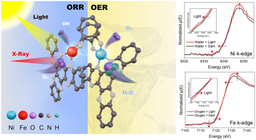
This project started with a simple question "How do the nucleosynthetic anomalies on palladium compare to those reported for neighbouring elements?". Nucleosynthetic anomalies are small variations in the isotope abundance of elements in Solar System material that arise due to a heterogeneous distribution of stardust in the Solar System. This dust formed around stars with ongoing nucleosynthesis, i.e. the production of fresh nuclei, and as a result retains a unique isotopic fingerprint of the environment they formed in.
Refractory elements like ruthenium and molybdenum show large correlated nucleosynthetic anomalies that can be described by mixing the terrestrial composition with the bulk Solar System s-process component, one of the three main nucleosynthetic sources for elements heavier than iron. In contrast, more volatile elements, e.g. cadmium and tellurium, do not show any resolvable nucleosynthetic anomalies. This suggests that the volatility of elements plays an important role in determining magnitude of nucleosynthetic anomalies. What makes palladium interesting is that it sits between these two different groups of elements in terms of volatility making it an ideal element to explore this hypothesis.
We focused our study on the iron meteorites. These meteorites are the fragments of old planetary cores that were created and subsequently destroyed in the first few tens of millions years of Solar System history. They are enriched in the so called siderophile, or iron loving, elements, which includes palladium, and show large nucleosynthetic anomalies for both ruthenium and molybdenum. We found that palladium does show resolvable nucleosynthetic anomalies that correlate with those reported for ruthenium and molybdenum. However, the anomalies we find are smaller than predicted from mixing between the terrestrial composition and the bulk Solar System s-process component. This finding corroborates the hypothesis we set out to test but inevitably leads to the question of how the volatility of an elements influences the magnitude of nucleosynthetic anomalies found in meteorites?

A visual representation of our model. Stardust condenses around different types of stars and is transported to the interstellar medium. The majority of stardust comes from asymptotic giant branch (AGB) stars where isotopes are produced by the s-process. Interstellar dust condenses around stardust grains in the interstellar medium. Thermal processing of dust in the protoplanetary disk preferentially destroyed interstellar dust resulting in a relative enrichment of stardust in regions closer to the sun.
The key to answering this question is understanding the entire life cycle of stardust, from its creation around stars to the eventual accretion into planetary bodies in our Solar System. To understand this we undertook a thorough literature review on a broad range of topics from numerical modelling of nucleosynthesis in stars to astronomical observations of dust in the interstellar medium to the composition of individual stardust grains. Using this knowledge, together with the findings of our own study, we constructed a novel new model that can simultaneously explain the origin of nucleosynthetic anomalies and the magnitude of these anomalies in Solar System material.
In short, our model postulates that as dust was accreting to the protoplanetary disk it was subjected to thermal processing, due to irradiation by the young Sun, that preferentially destroyed interstellar dust that lacks the unique stellar isotopic fingerprints that we find in stardust. This resulted in a relative enrichment of stardust, that was predominately made up of s-process material, in regions closer to the sun. This explains why we find correlated nucleosynthetic anomalies in meteorites that have an s-process isotopic signature. The smaller nucleosynthetic anomalies we find in palladium, compared more refractory elements, and the lack of resolvable anomalies in more volatile elements can be explained by incomplete condensation of elements into stardust in s-process stellar environments. The more volatile elements will instead be homogenised and incorporated into dust in the interstellar medium, thereby losing its unique stellar signature.
As a first attempt to constrain the origin of nucleosynthetic anomalies with a broad range of interdisciplinary constraints our model presents a good framework to build upon. Continuing research by the community will provide additional constraints that can be tested against our model and further our understanding of the processes that are responsible for creating nucleosynthetic anomalies in our Solar System.
Follow the Topic
-
Nature Astronomy

This journal welcomes research across astronomy, astrophysics and planetary science, with the aim of fostering closer interaction between the researchers in each of these areas.
Related Collections
With Collections, you can get published faster and increase your visibility.
Progress towards the Sustainable Development Goals
Publishing Model: Hybrid
Deadline: Ongoing




Please sign in or register for FREE
If you are a registered user on Research Communities by Springer Nature, please sign in